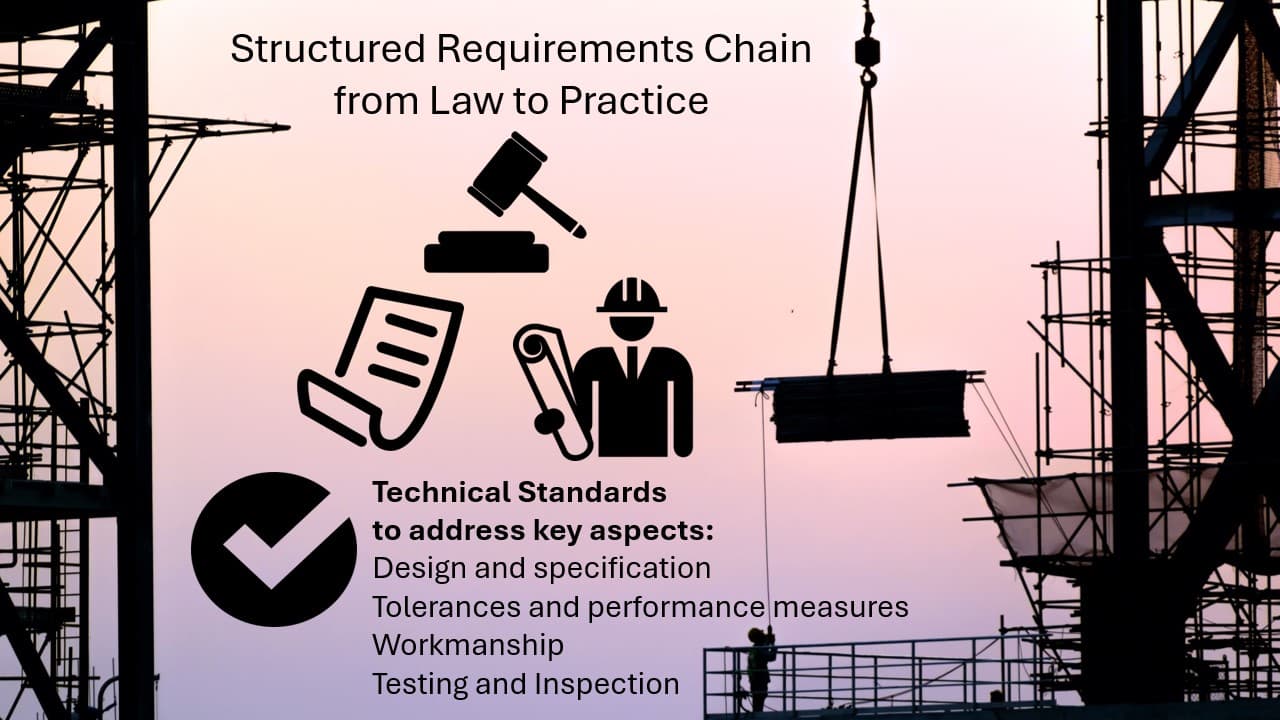Structured Requirements Chain from Law to Practice



Structured Requirements Chain from Law to Practice
Across the world, construction projects are governed by a structured hierarchy of requirements designed to ensure safety, compliance, and consistent quality. While the exact framework varies between countries, a common pattern exists: legislation establishes mandatory outcomes, guidance provides practical routes to compliance, and technical standards define measurable detail.
The United Kingdom provides a clear example of how these layers interact.
The Hierarchy of Construction Requirements
At the top of any national framework sit the legislative requirements — laws and regulations that define what must be achieved. These are usually enacted by government and form the only truly mandatory part of the system. They cover broad outcomes such as structural safety, fire protection, accessibility, and environmental performance.
Beneath legislation are guidance documents and codes of practice, often issued by appointed authorities, industry bodies, or professional institutions. These documents interpret the legal requirements and provide practical examples of how compliance can be achieved. They commonly reference recognised technical standards — for instance, British Standards (BS), European Standards (EN), or International Standards (ISO) — but crucially, these standards are not automatically applicable. They only take effect when specifically cited in legislation, guidance, or a project’s own technical documentation.
The Role of Technical Standards
When adopted, national or international standards provide detailed, consistent methods for design, specification, and verification. In general, these standards address four essential aspects:
1. Design and Specification – how to design or specify construction works, materials, and systems.
2. Performance and Tolerances – the performance levels, tolerances, or durability criteria that materials and systems must meet.
3. Workmanship – how construction works should be executed to achieve the intended quality and reliability.
4. Testing and Inspection – how to test performance or inspect workmanship to verify compliance.
In the UK, for example, British Standards are frequently referenced in design specifications or codes of practice. Yet they apply only when explicitly invoked — they are supporting tools, not automatic legal obligations.
Manufacturer Specifications and Product Data
Alongside standards, manufacturers also provide technical specifications and product data that describe the properties, performance, and installation requirements of their materials or systems. These documents are an essential part of the construction information flow.
Designers may refer to manufacturer specifications to ensure that selected products meet both the project’s design intent and the relevant standards or regulatory criteria. In many cases, these manufacturer specifications include testing data or certification demonstrating compliance with recognised standards — providing a bridge between technical design requirements and real-world materials or components.
Linking Requirements through Veribim-KG
To strengthen this structured chain and embed it directly into the digital project environment, the veribim-kg initiative introduces a knowledge-graph approach to construction compliance. Veribim-kg aims to represent all requirements applicable to a specific project — including laws, guidance, standards, manufacturer data, and client-defined criteria — within an interconnected data model. Each requirement can be linked to the corresponding elements in a BIM model, allowing, for example, a wall, door, or HVAC component to be connected directly to the regulations and standards it must satisfy. This creates a transparent “knowledge layer” where compliance is no longer confined to documents but becomes structured, queryable data within the model itself. The result is a living golden thread of accountability and traceability that supports automated checking, clearer communication, and more reliable verification throughout the asset lifecycle.
From Client Requirements to Design Intent
Construction projects typically begin with Customer Requirements — sometimes known as the Employer’s Requirements or Client Brief — which define what the client expects the project to deliver. These are developed by the design team into a Design Intent, which guides how the outcomes will be achieved in technical terms.
The design reports, drawings, and specifications usually reference the relevant standards and, where appropriate, manufacturer data to establish verifiable criteria for design, materials, and workmanship. By doing so, these references become project-level operational requirements, ensuring consistency and accountability in delivery.
A Structured Chain from Law to Practice
Whether in the UK or elsewhere, this structure ensures that construction operates within a transparent and traceable framework:
- Legislation sets the mandatory outcomes.
- Guidance explains recognised routes to achieving them.
- Standards and manufacturer data, when adopted, define the detailed methods, materials, and performance criteria used for design and verification.
By understanding this hierarchy — and by recognising that technical standards and manufacturer specifications derive their authority from explicit reference rather than assumption — construction professionals can navigate compliance more effectively and deliver projects that are both lawful and technically sound.